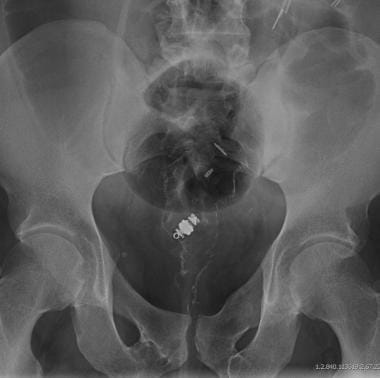Background
The treatment of rectal foreign bodies has been discussed in the medical literature for many years. [1, 2] Controlled studies of patients with rectal foreign bodies have not been conducted, and the literature is largely anecdotal or consists of small patient series. [3, 4] The approach to the management of these patients has not changed in the last 10-20 years. These patients usually present to the emergency department (ED) because of pain, discomfort, or foreign body sensation, often after multiple attempts to remove the object. Presentation is almost always delayed because of embarrassment. [5, 6]
The keys to adequate care for these patients are respect for their privacy, evaluation of the type and location of the foreign body, determination if removal can be performed in the ED or if operative referral is needed, and use of appropriate techniques for removal. Caregivers should refrain from making disparaging or comical remarks concerning the nature of the problem and prevent invasions of the patient’s privacy by curious hospital staff. [7] This is not just a priority for patient respect and privacy, but also a medicolegal issue for the hospital and staff.
Etiology
In the vast majority of cases, rectal foreign bodies are inserted during erotic activity. The objects are typically dildoes or vibrators, although almost any object can be seen, including light bulbs, candles, shot glasses, and odd or unusually large objects such as soda bottles or beer bottles.
Less commonly, foreign bodies are inserted rectally in an attempt at concealment. Typically, these objects are drug packets; less often, they are weapons, such as knives or guns. Some psychiatric patients will purposefully conceal sharp objects in their rectums in an attempt to injure the examining provider when he or she performs a rectal examination. Finally, more commonly in older patients, rectal foreign bodies used for prostatic massage or to break up fecal impactions may be lost during this activity.
Some rectal foreign bodies are initially swallowed and then transit through the gastrointestinal (GI) tract. Examples of the latter include toothpicks, popcorn, bones, sunflower seeds, [8, 9] and, in more recent years, camera pills used in gastrointestinal studies (see the image below). Rectal foreign bodies can also be the result of assault, including child abuse. The weapon used in the assault is typically a blunt object but may be any object. [10]
 Rectal Foreign Bodies. The patient swallowed a camera pill that became lodged in the rectum at a prior surgical anastomosis site and had to be removed via sigmoidoscopy.
Rectal Foreign Bodies. The patient swallowed a camera pill that became lodged in the rectum at a prior surgical anastomosis site and had to be removed via sigmoidoscopy.
Rectal foreign bodies can be classified as high-lying or low-lying, depending on their location relative to the rectosigmoid junction. This distinction is important. Objects that are above the sacral curve and rectosigmoid junction are difficult to visualize and remove, and they are often unreachable with rigid proctosigmoidoscopy. Low-lying rectal foreign bodies, however, are normally palpable on digital examination and are candidates for ED removal.
Frequently, delays in presentation and multiple attempts at self-removal lead to mucosal edema and muscular spasms, which further hinder removal. Rectal lacerations and perforations may occur but are less common than other complications.
Epidemiology
There are no reliable data on the frequency of rectal foreign bodies. The older literature contains occasional case reports; more recently, several case series and descriptions of evaluation and extraction techniques have been published. It is likely that the use of various objects for anal eroticism is increasing, resulting in an increased incidence of retained rectal foreign bodies. [11]
The age distribution is bimodal, with peaks in the 20s (thought to be due to anal eroticism) and 60s (thought to be secondary to the use of foreign objects for prostatic massage). Most patients are in the age range of 20-40 years. [10, 12] The prevalence is much higher in males than in females: the ratio is approximately 28:1. [13, 14] The few published series that list race note no significant differences between racial groups.
Prognosis
For the vast majority of rectal foreign bodies, the prognosis is excellent. For foreign bodies that result in perforation of the rectal or colon wall, the prognosis is also good with the use of antibiotics and operative intervention. Deaths in patients with rectal foreign bodies are rare and are almost always the result of perforation with prolonged delay until presentation for care.
Morbidity/mortality
Mortality is rare and results from bleeding, rectal perforation or laceration, and infectious complications. [10] Morbidity is somewhat more common and is primarily the result of rectal laceration or perforation.
Complications
The most common complications of rectal foreign bodies are rectal laceration and perforation, which are diagnosed by direct visualization. Questionable cases should be referred to a general surgeon. Other complications that may be seen include infection with abscesses and sepsis.
All cases of suspected laceration or perforation should be treated by administering a broad-spectrum antibiotic such as piperacillin-tazobactam.
-
Rectal Foreign Bodies. Typical appearance of a vibrator in the rectum.
-
Rectal Foreign Bodies. Vibrator in the rectum. The patient attempted self-removal with a pair of salad tongs, which also became lodged, resulting in two rectal foreign bodies. Multiple attempts at self-removal are typical in patients with rectal foreign bodies.
-
Rectal Foreign Bodies. The patient swallowed a camera pill that became lodged in the rectum at a prior surgical anastomosis site and had to be removed via sigmoidoscopy.





